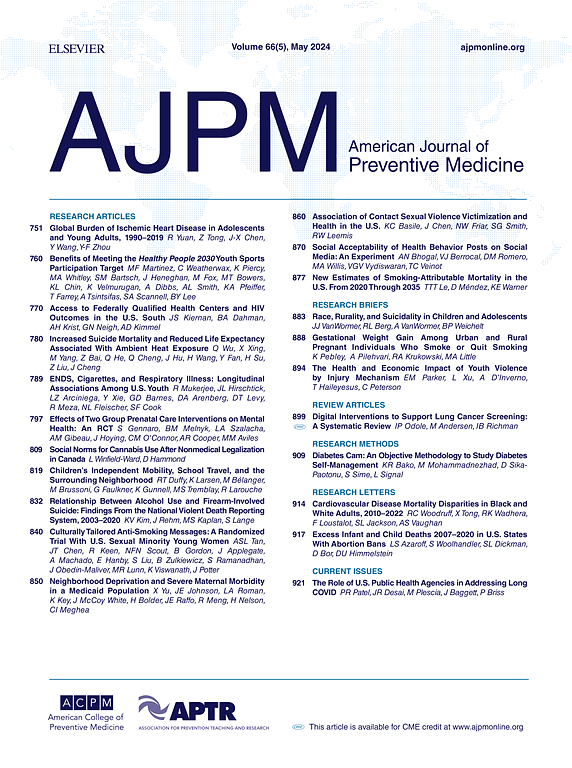2018-2021 年美国慢性病负担的空间和时间模式。
IF 4.3
2区 医学
Q1 MEDICINE, GENERAL & INTERNAL
引用次数: 0
摘要
导言:在美国,慢性病是导致死亡和残疾的主要原因。虽然存在评估多种慢性病负担的个人层面指数,但缺乏人口层面的定量工具。这一差距阻碍了人们对慢性病地理分布和影响的了解,而这对有效的公共卫生战略至关重要。本研究旨在构建用于评估县级疾病负担的慢性病负担指数(CDBI),识别地理和时间模式,并调查CDBI与社会脆弱性之间的关联。方法:采用CDC的PLACES数据库(2018-2021年)中的20项健康测量指标,通过主成分分析构建年度县级CDBI。利用Getis-Ord Gi*确定慢性病负担的地理热点。多项式逻辑回归模型和双变量地图用于评估 CDBI 与疾病预防控制中心的社会脆弱性指数 (SVI) 之间的关联。分析于 2023-2024 年进行:肯塔基州和西弗吉尼亚州的慢性病负担普遍较重,而俄亥俄州和得克萨斯州的慢性病负担则有所增加。慢性病负担与 SVI 高度相关(ORQ5 vs Q1= 7.6,95% CI:[6.6, 8.8]),非大都市区县的 CDBI 值升高(OR = 14.6 95% CI:[9.7, 21.9]):CDBI 是评估人口慢性病负担的有效工具。结论:CDBI 为在人口层面评估慢性病负担提供了有效的工具,识别高负担和脆弱社区是促进资源分配以提高医疗保健的公平性和增进对健康差异的了解的关键性第一步。本文章由计算机程序翻译,如有差异,请以英文原文为准。
Spatial and Temporal Patterns of Chronic Disease Burden in the U.S., 2018–2021
Introduction
Chronic diseases are primary causes of mortality and disability in the U.S. Although individual-level indices to assess the burden of multiple chronic diseases exist, there is a lack of quantitative tools at the population level. This gap hinders the understanding of the geographical distribution and impact of chronic diseases, crucial for effective public health strategies. This study aims to construct a Chronic Disease Burden Index (CDBI) for evaluating county-level disease burden, to identify geographic and temporal patterns, and investigate the association between CDBI and social vulnerability.
Methods
A total of 20 health measures from CDC's PLACES database (2018–2021) were used to construct annual county-level CDBIs through principal component analysis. Geographic hotspots of chronic disease burden were identified using Getis–Ord Gi*. Multinomial logistic regression models and bivariate maps were used to assess the association between CDBI and CDC's social vulnerability index. Analyses were conducted in 2023–2024.
Results
Counties with high chronic disease burden were predominantly clustered in the southern U.S. High persistent chronic disease burden was prevalent in Kentucky and West Virginia, while increased burden was observed in Ohio and Texas. Chronic disease burden was highly associated with social vulnerability index (ORQ5 vs Q1=7.6, 95% CI: [6.6, 8.8]), with nonmetro-urban counties experiencing elevated CDBI (OR=14.6, 95% CI: [9.7, 21.9]).
Conclusions
The CDBI offers an effective tool for assessing chronic disease burden at the population level. Identifying high-burden and vulnerable communities is a crucial first step toward facilitating resource allocation to enhance equitable healthcare access and advancing understanding of health disparities.
求助全文
通过发布文献求助,成功后即可免费获取论文全文。
去求助
来源期刊

American Journal of Preventive Medicine
医学-公共卫生、环境卫生与职业卫生
CiteScore
8.60
自引率
1.80%
发文量
395
审稿时长
32 days
期刊介绍:
The American Journal of Preventive Medicine is the official journal of the American College of Preventive Medicine and the Association for Prevention Teaching and Research. It publishes articles in the areas of prevention research, teaching, practice and policy. Original research is published on interventions aimed at the prevention of chronic and acute disease and the promotion of individual and community health.
Of particular emphasis are papers that address the primary and secondary prevention of important clinical, behavioral and public health issues such as injury and violence, infectious disease, women''s health, smoking, sedentary behaviors and physical activity, nutrition, diabetes, obesity, and substance use disorders. Papers also address educational initiatives aimed at improving the ability of health professionals to provide effective clinical prevention and public health services. Papers on health services research pertinent to prevention and public health are also published. The journal also publishes official policy statements from the two co-sponsoring organizations, review articles, media reviews, and editorials. Finally, the journal periodically publishes supplements and special theme issues devoted to areas of current interest to the prevention community.
 求助内容:
求助内容: 应助结果提醒方式:
应助结果提醒方式:


